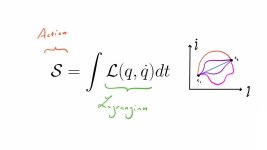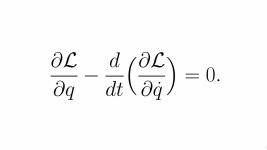repoman
Contributor
This is some cool stuff that spans classical and quantum mechanics.
I watched a couple excellent derivations of the Euler-Lagrange equation and how it applies to action then I played around with a simple example.
Take a projectile shot up in the air with initial velocity, v0 and follow it until it stop and is ready to fall back. The Action integral for this path was -1/6 m(v0 )3/g which is in units of J-s or energy*time.
Did the same for having the projectile reach the vertex point in the same time but with a constant velocity and got Action = -1/8 m(v0 )3/g which is larger.
Then had the projectile go twice as fast and then stay stationary for the rest of the time (like a taxi meter running). The action in this case was + 3/8 m(v0 )3/g
It is kind of hard to wrap my head around this, but it starting to make sense.
Also, what is the physical significance to units of E*t (energy*time) being the same as P*x (momentum*position)?
I watched a couple excellent derivations of the Euler-Lagrange equation and how it applies to action then I played around with a simple example.
Take a projectile shot up in the air with initial velocity, v0 and follow it until it stop and is ready to fall back. The Action integral for this path was -1/6 m(v0 )3/g which is in units of J-s or energy*time.
Did the same for having the projectile reach the vertex point in the same time but with a constant velocity and got Action = -1/8 m(v0 )3/g which is larger.
Then had the projectile go twice as fast and then stay stationary for the rest of the time (like a taxi meter running). The action in this case was + 3/8 m(v0 )3/g
It is kind of hard to wrap my head around this, but it starting to make sense.
Also, what is the physical significance to units of E*t (energy*time) being the same as P*x (momentum*position)?


